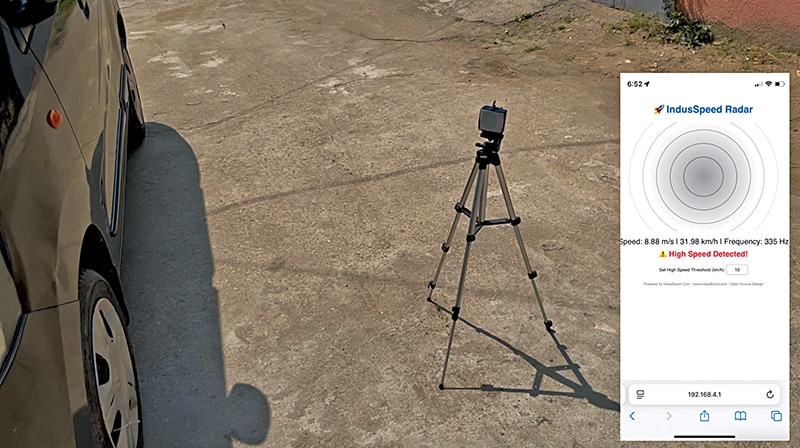
Measuring the speed of moving vehicles and objects is critical for ensuring road safety, conducting traffic analysis, and supporting research applications. Conventional systems are often bulky or costly, whereas current requirements emphasise compact, efficient, and affordable alternatives.
This system offers a portable, wireless speed detection solution based on the Doppler effect. It analyses frequency shifts in millimetre wave signals caused by the relative motion between a moving object and the sensor. The system accurately measures the velocity of fast-moving targets such as cars, motorbikes, and trains through precise millimetre wave transmission and reception.
POC Video Tutorial:
This smart Doppler radar system is designed for versatility and supports effective speed monitoring, whether mounted on a roadside pole or used as a portable unit paired with mobile devices.

The Bill of Materials table above details the required components, while Fig. 1 shows the author’s assembled prototype being tested on a tripod. The system can even be mounted on a roadside pole for smart city applications and continuous monitoring.
| Bill Of Materials | ||
| Components | Quantity | Description |
| IndusBoard Coin (ESP32-S2) | 1 | Microcontroller board with built-in Wi-Fi |
| HB100 Doppler radar sensor | 1 | Measures speed based on the Doppler effect |
| LM358 amplifier module | 1 | Amplifies HB100 signal for better detection |
| USB Type-C cable | 1 | For power and programming |
| 3.3V battery / 3.3V-5V DC | 1 | For power supply |
| An enclosure for the device | 1 | For its protection against adverse weather |
Understanding the Doppler Effect in Radar
The Doppler effect is a fundamental principle behind modern radar speed detection systems. It refers to the change in the frequency and wavelength of waves, such as sound or radio waves, caused by the relative motion between the wave source and the observer.
Two main scenarios illustrate this phenomenon with sound:
1. Moving source, stationary observer
If the sound source moves toward the observer, the sound waves become compressed, resulting in a higher observed frequency (a higher-pitched sound). Conversely, the sound waves stretch out when the source moves away, causing a lower observed frequency (a lower-pitched sound).
2. Stationary source, moving observer
If the observer moves toward the stationary source, the perceived frequency increases. If the observer moves away, the perceived frequency decreases, producing a similar Doppler effect.
Radar-based speed detection systems operate on the same core principle, but instead of sound waves they use radio frequency (RF) signals, typically in the microwave range.
How Doppler Radar Works
Doppler radar operates by transmitting RF signals in a specific direction using antennas or sensors. These are typically mounted on a vehicle’s front grille or bumper, or externally on poles or portable systems. The emitted signals travel outward, scanning the surroundings for potential obstacles, vehicles, or pedestrians.
When these signals encounter an object, a portion of the signal is reflected back to the radar receiver. If the object is stationary or moving at the same speed as the radar, the frequency of the returning signal remains mostly unchanged. However, if the object is in motion relative to the radar, the reflected signal undergoes a Doppler shift.
A positive Doppler shift (increased frequency) occurs when an object approaches, while a negative Doppler shift (decreased frequency) happens when an object moves away. By analysing this frequency shift, the system can accurately determine the speed of the moving object in real time, enabling precise detection without physical contact or complex setups.
Circuit and Working
Fig. 2 shows the circuit diagram of the automatic Doppler radar system. It is built using the IndusBoard Coin, HB100 Doppler radar module, and LM358 amplifier. This system processes real-time speed data and displays it on a wireless dashboard that is accessible directly from a smartphone, without requiring an internet connection.








